FLOODS IN CHINA

Flood preparedness poster
Floods are serious problems in China. Every year hundreds die in them during the June and July rainy season. At one time round 500 people died from them Yunnan Province alone. Flooding is common in China's mountainous areas and in the east and south. A study in the journal Irrigation and Drainage in 2010, said one third of China's farmland, two-thirds of its people, more than 60 percent of its cities and 80 percent of its GDP were threatened by floods.
China is hit by heavy summer rainfalls every year. China’s south and west experienced a seven-fold increase in heavy rains in the 2000s from what they experienced in the 1950s. The flood and landslide problems are often exacerbated by deforestation and erosion. Without trees, plants and bushes to absorb the water and hold the earth in place, water runs off quickly and causes flash floods and saturates slopes, causing landslides.
The five worst floods in history, based on the number of people dead, all occurred in China: Worst Recorded Floods: (number of dead): 1) Yangtze River, China, August 1931 (500,000–4,000,00); 2) Huang He (Yellow River), China, 1887 (900,000–2,000,000); 3) 1938 Yellow River flood (500,000–800,000), 1939; 4) Banqiao Dam failure and floods, 1975, (229,000) 1975; 5) 1935 Yangtze flood(145,000), 1935. ) Holland, 1228 (100,000); 7) Indonesia, Aug 27, 1883 (100,000); 8) Morvi, India, Aug, 11, 1979 (15,000); 9) Bangladesh, Oct 10, 1960 (6,000); 10) Galveston, TX, Sept. 8, 1900 (5,000). [Source: Wikipedia for China; World Almanac for the others]
According to the Guinness Book of Records, the deadliest flood ever killed 900,000 people around the Yellow River in October 1887. A flood in China in 1642 is estimated to have killed 300,000 people.
Articles on NATURAL DISASTERS IN CHINA factsanddetails.com and LAND AND WEATHER OF CHINA factsanddetails.com
RECOMMENDED BOOKS: “The Nature of Disaster in China: The 1931 Yangzi River Flood” by Chris Courtney Amazon.com; “Floods, Famines and Wars: The American Advent Mission Society in China” by David E. Dean Amazon.com; “Flood Risks and Land Use Conflicts in the Yangtze Catchment, China and at the Rhine River, Germany: Strategies for a Sustainable Flood Management” by Tong Jiang, Lorenz King, et al. Amazon.com; “Natural Disasters in China” by Peijun Shi (2016) Amazon.com; “Economic Impacts and Emergency Management of Disasters in China” by Xianhua Wu and Ji Guo (2021) Amazon.com; “Landslides in the Thick Loess Terrain of North-West China” by Edward Derbyshire, Xingmin Meng, et al. Amazon.com; “Landslide Disaster Mitigation in Three Gorges Reservoir, China” by Fawu Wang and Tonglu Li Amazon.com; “Monsoons over China” by Ding Yihui Amazon.com; “Evolution of the Large Scale Circulation, Cloud Structure and Regional Water Cycle Associated with the South China Sea Monsoon During May-June, 1998 (2013) by NASA Technical Reports Server (Ntrs) Amazon.com; “Continent in Dust: Experiments in a Chinese Weather System” by Jerry C. Zee Amazon.com; “Aridity Trend in Northern China” by Congbin Fu and Huiting Mao Amazon.com
Yellow River Floods
From time to time the Yellow River overflows its banks and fills huge plains with large amounts of water. Floods sometimes occur when blocks of ice block the Yellow River. About once a century these floods reach catastrophic levels. The Yellow River flows in braided streams, a network of smaller channels that weave in and out of each other. In each channel silt slowly builds the riverbed above the surrounding landscape and gives the river its devastating habit of breaking its banks and changing course.
When the levees of the Yellow River break, which happens with some regularity, the countryside is devastated. When the river’s dikes were breached in 132 B.C., floods occurred in 16 districts and a new channel was opened in the middle of the plain. Ten of millions of peasants were affected. The break remained for 23 years until Emperor Wu-ti visited the scene and supervised its repair.
In A.D. 11, the Yellow River breached its dikes near the same place, and the river changed course and forged an new path to sea, a hundred miles away from its former mouth. Repair work took several decades. The A.D. 11 flood caused a famine and mass migration that was followed by a massive drought that helped set off a series of rebellions that led to the ouster of Wang Mang and the downfall of the first the Han Dynasty. By A.D. 25 a descendants of Western Han royalty had retaken the throne, establishing the eastern Han Dynasty which lasted another 200 years.
See Separate Articles YELLOW RIVER factsanddetails.com
Yangtze Floods
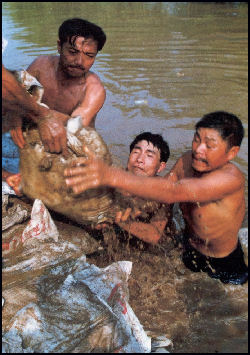
Placing sandbags The Yangtze River is the longest and busiest river in Asia, the longest river in the world that flows entirely within one country. and the third longest river in the world after the Nile and the Amazon. Extending for 6,380 kilometers (3,964 miles), it is the sixth-largest river in the world in terms of the amount of water discharged into the sea (behind the Amazon, Congo, Ganges-Padma, Orinoco and Madiera. The Yangtze releases 8 million gallons into the East China Sea every second.
The Yangtze River frequently overflows its banks and fills huge plains with large amounts of water, causing catastrophic flooding. There are floods every year during the June-to-September monsoon season. On average at least several hundred people are killed in Yangtze River floods every year. Some years there are devastating floods.
The Yangtze is responsible for 70 to 75 percent of China’s floods. Floods on the river in the 20th century alone have killed more than 300,000 people. There were catastrophic floods on the Yangtze in 1931, 1935 and 1954 and 1998. Over 2,000 are believed to have died in the flood of 1991. Some 4,100 died in the floods in 1998.
In 1931, 140,000 people were drowned when Yangtze dikes gave way. A Yangtze River flood in 1954 killed 30,000 people outright and perhaps an additional 200,000 through starvation and disease. One villager who lived through it told the Washington Post, "The corpses were put in coffins but they could not be buried. They were just stacked up.” The Three Gorges Dam has reduced flood risks in the middle stretch of the river but the risks of flooding remains high on the lower stretches.
See Separate Article: YANGTZE RIVER factsanddetails.com
1887 Yellow River Flood
The 1887 Yellow River flood in Qing-Era China began in September 1887 and killed at least 930,000 people. It was the single deadliest flood in China, in turn making it one of the top disasters in China and the world based on death toll. On September 28, 1887, the Yellow River, swollen by days of heavy rain, overcame the dikes, causing a massive flood. [Source: Wikipedia]
The waters of the Yellow River are generally thought to have broken through the dikes in Huayuankou, near the city of Zhengzhou in Henan province. Owing to the low-lying plains near the area, the flood spread very quickly throughout Northern China, covering an estimated 130,000 square kilometers (50,000 square miles) — an area roughly equal that of Louisiana or Costa Rica. Flood waters swamped agricultural settlements and commercial centers. After the flood, two million were left homeless. The resulting famine, pandemic and lack of basic essentials claimed as many lives as those lost directly to the flood.
Arthur Henderson Smith wrote in “Chinese Characteristics”, published in 1894: The terrible suffering caused by the overflow of the Yellow River and its sudden change of channel, have been past all computation or comprehension. Some of the finest parts of several different provinces have been devastated, and fertile soil has been buried a fathom deep in blighting sands of desolation. Thousands of villages have been annihilated, and the 'wretched inhabitants who have escaped death by flood, have been driven forth as wanderers on the face of the earth, without homes and without hope. Great masses of human beings, suddenly ruined, and reduced to desperation by no fault of their own, are not agreeable objects of contemplation to any government.
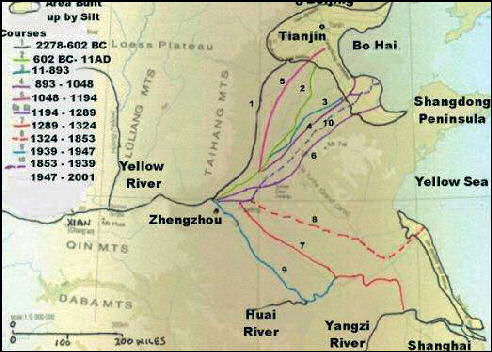
Flood-induced course changes on the Yellow River
1931 China Flood, the Deadliest Natural Disaster Ever
In 1931, hundreds of thousands, maybe millions, of people were drowned when Yangtze dikes gave way. It is one of the deadliest disasters ever and the true death toll unknown. Randi Mann of the Weather Network wrote: “From June to August 1931, areas of central and eastern China flooded, including densely populated cities like Wuhan and Nanjing. The death toll of the floods ranges between 422,499-4,000,000, depending on the source. [Source: Randi Mann, Weather Network, August 18, 2021]
“China faced some extreme weather in the late 1920s and early 30s. From 1928 to 1930, the country was in a drought. Then the 1930 winter was harsh, which created substantial deposits of snow and ice around mountainous areas. At the beginning of 1931, the snow and ice started to melt, flowing downstream into the Yangtze River. The area is used to increased water levels during spring, summer, and fall, but the flow was consistent in 1931. Those living in low areas left their homes.
“ Areas along the Yangtze reported rain over 600 millimeters of rain in June. The river's water levels reached its highest since record-keeping began. On August 25, 1931, a dike along Lake Gaoyou was breached. The floods covered around 180,000 square kilometres, approximately the size of New York, New Jersey, and Connecticut combined. The floods destroyed extensive housing and farmland. Approximately 15 per cent of wheat and rice crops were destroyed in the Yangtze Valley. The floods impacted the economy as the price of vital commodities skyrocketed.
“The stress on the land and economy caused many areas to go into famine. Some people ate tree bark and weeds, and other people sold their children to survive. Some people even turned to cannibalism. Disease, including cholera, and measles, malaria, spread across displaced refugee communities.
1938 Deliberate Man-Caused Yellow River Flood
In a tactic intended to halt the southward movement of Japanese soldiers from Manchuria before World War II, Chiang Kai-shek ordered his soldiers to breach the levees of the Yellow River and purposely divert its flow. At least 200,000, maybe millions, died, millions more were made homeless and the Japanese advanced anyway. The resulting 1938 Yellow River flood was a flood created by the Nationalist Government in central China during the early stage of the Second Sino-Japanese War in an attempt to halt the rapid advance of the Japanese forces. It has been called the "largest act of environmental warfare in history." [Source: Wikipedia +]
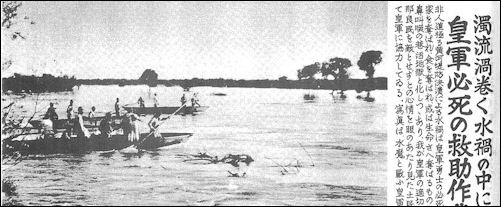
Japanese rescue during the 1938 Yellow River flood
Following the onset of the Second Sino-Japanese War in 1937, the Imperial Japanese Army marched rapidly into the heart of Chinese territory. By June 1938, the Japanese had control of all of North China. On June 6, they captured Kaifeng, the capital of Henan, and threatened to take over Zhengzhou, the junction of the arterial Pinghan and Longhai Railways, and Japanese success would have directly endangered the major cities of Wuhan and Xi'an. +
To stop further Japanese advances into the western and southern part China, Chiang Kai-shek, at the suggestion of Chen Guofu, determined to open up the dikes on the Yellow River near Zhengzhou. The original plan was to destroy the dike at Zhaokou, but due to difficulties at that location the dike was destroyed on June 5 and June 7 at Huayuankou, on the south bank. Waters flooded into Henan, Anhui, and Jiangsu. The floods covered and destroyed thousands of square kilometers of farmland and shifted the mouth of the Yellow River hundreds of miles to the south. Thousands of villages were inundated or destroyed and several million villagers driven from their homes and made refugees. An official Nationalist post-war commission estimated that 800,000 were drowned, which may be an underestimate. +
See 1938 Yellow River Flood Under SECOND SINO-JAPANESE WAR (1937-1945) factsanddetails.com
Yellow River Floods, Relief and Misery in the 19th Century
Arthur Henderson Smith wrote in “Chinese Characteristics”, published in 1894: “Whenever a river breaks its banks and inundates a vast region. It is often not easy to secure remission of the taxes, even when the people have nothing to eat, and in the great majority of cases government relief of the suffering region is apparently never thought of by any one. In the great floods which have resulted from the changes of channel in the Yellow River within the past few years, and in the simultaneous famines in Henan, Anhui, Shandong and Shaanxi, the government has done far more for relieving the sufferers than it did in the great famine of 1877-78. But there are many reasons for suspecting that this relief — limited at best — is due to what some philosophers have termed " enlightened Selfishness " and from a clearer perception than heretofore that, in levying taxes, out of nothing, nothing comes. [Source:“Chinese Characteristics” by Arthur Henderson Smith, 1894]
“When the director general of the Yellow River, by whose exertions the seemingly impossible task of closing, the great breach has been accomplished, suggests to the Emperor that the only adequate method of dealing with the mighty problem presented by China's Sorrow is an extended survey, the proposition is rebuked as "premature and ostentatious." Enormous sums are lavished on an Imperial wedding, but no outlay is provided for the relief of three provinces ruined by the Yellow River. At the same time when foreign funds were sent'into famine-stricken districts, to buy grain for the relief of people who were starving by hundreds of thousands, the government was exporting grain from these same regions to be sent to Peking as taxes. The people are constantly made to realize that the collection of the government tax is the main feature in current history. If any part of this tax is remitted (in consideration of its being impossible to, collect it), this is called "Imperial favor."
In 1899, Arthur Henderson Smith wrote in “Village Life in China”:An extreme case of chronic misery from this cause is found in the Hsiên District of Chih-li, where there is a section wedged in between the high artificial banks of two rivers. Every year many villages are deluged as matter of course, and the houses have been repeatedly destroyed. No autumn crop can ever be raised here, but wheat is put in after the waters have subsided. In the winter one sees many of the houses with doors and windows plastered up, almost all the inhabitants having gone off in droves to beg a living where they can, returning the next spring to look after their wheat. This has become a regular practice even with families who own fifty or sixty acres of land, and who elsewhere would be called well off. [Source: “Village Life in China” by Arthur Henderson Smith, Fleming H. Revell Company, 1899, The Project Gutenberg]

Flood in 1931
Dikes, Disputes and Yellow River Flooding in the 19th Century
Arthur Henderson Smith wrote in “Chinese Characteristics”: “ Prominent among these sources of dispute are those which arise from the danger of flowing, or more frequently of overflowing water. One village or set of villages is situated on a flat, liable to inundation when a river breaks its banks. To guard against the ruin which is thus threatened, a group of villages, perhaps with the knowledge and consent of the local magistrate for the time being, provides a bank which shall prevent the waters from overwhelming any of these villages. But water must go somewhere, and in a thickly settled country such as a great part of China is, it cannot go anywhere without ruin to many people. When such a bank has been newly built or repaired, and a break in the river is expected, large volunteer details from the villages interested in keeping the water out watch the bank to see that it is not disturbed. The villagers living within the area which will be flooded by the dreaded waters sally out by night and attempt to cut the bank, if possible in such a way as to make it appear that it was done by the action of the waters. It is when hostile parties meet under these conditions that the most sanguinary battles take place. [Source:“Chinese Characteristics” by Arthur Henderson Smith, 1894]
“To appeal to the magistrates in the first instance is recognized as useless, because no magistrate will do anything in the matter if he can avoid it, and even if he were willing, the rate of his movements would be such that the danger would have either passed or have been precipitated before the initial steps of the mandarin had been taken. As the very existence of the people is thus often at stake, the battles are sometimes of great ferocity, and many lives are lost. This leads to law-suits, which are not infrequently hushed up by the officials, that they may not lose their posts. It is for this reason that often no reference to these occurrences appears in the Peking Gazette. When we consider the extent of territory in China which is at times liable to such devastation as we have described, the magnitude of the evil may be faintly apprehended.
“During the almost unprecedented floods in North-China, in the summer of 1890, the phenomena here described were Witnessed on a great scale. A stream called the T'u-hai runs parallel with the course of the Yellow River on the north side, and is guarded by a lofty dyke. As additional protection to the districts north of the T'u-hai, smaller banks had been thrown up, to confine the waters to the south, in case the floods of previous years should be repeated. These banks, to the number of five or six, extended at intervals like the bars of a gridiron. When the great dyke of the T'u-hai actually broke, the inhabitants of the strip first inundated, finding their crops ruined, and their houses tumbling over them, raised a large foroe, and attempted to cut the bank to the north of them, in order to let out the water. This the villagers on the other side resisted with a still larger force, and the result was a battle. When the bank was at length broken down, the villagers in the second strip in their turn raised a posse and attacked the bank to the north of them, which was vigorously defended by the people whom it protected. By the time the water had reached its height, all of these several banks were in ruins, and the whole country was one vast lake. In the battles which had taken place, countless lives had been lost, the district magistrates doing absolutely nothing by way of prevention. Instances of this sort were reported all over the wide area of inundation, and fierce feuds were engendered, the bitter fruits of which will continue to appear for generations to come.
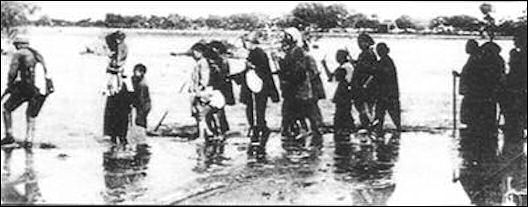
1938 flood in Huayuankou
“The cases here referred to, are those of extraordinary banks, provided by the people, in distinction from the regular ones which are found along water-courses which flow through the plains. In the season when an inundation from any of the rivers is threatened, the river banks are lined by an excited throng of villagers, representing the region liable to inundation. There is less danger of fights than in the circumstances already described, as the interests of all those engaged are substantially the same; but there are various characteristic phenomena, which serve as illustrations of our subject. Upon such occasions, the imminent public peril is supposed to swallow up all private considerations, and the " triumphant democracy," of which in China there is a great deal, rages almost unchecked. Large bodies of excited peasants, most of them threatened with the total ruin of all .their standing crops, However law-abiding they may ordinarily be, are not at such times easily controlled. They make their appearances in the villages ' which are nearest to the river bank, and under pretence of stopping an 'opening chasm in the river-bank, seize on whatever they happen to see, and take whatever they demand. In a case reported to the writer on a recent occasion, a band of this sort confiscated the entire furniture of a drug-shop, — counters, expensive chests of drawers, etc., to throw into a hole in the river-bank, apparently out of a spirit of mere wanton mischief. A few years ago at the same point of the river, the local subordinate (erh-ya) representing the district magistrate was reported to have been dragged out by the queue, and much of the furniture of his yamen, down to the very tea-cups, taken with it, all "to stop the break in the bank." The salt-hongs which in ordinary times oppress the people by forcing them to pay full price for twelve ounces of Salt instead of sixteen are, at times like these, open to reprisals of this nature. In short, any spite can be vented upon its victim with comparative impunity, if it is only done by a considerable number of persons, and under colour of using materials for the public good.
Typhoon Nina and the Collapse of the Banqiao Dam in 1975 Kills 229,000
Typhoon Nina, which struck China and Taiwan in August 1975, was the fourth-deadliest tropical cyclone on record. Approximately 229,000 people died after the Banqiao Dam collapsed and devastated areas downstream. The collapse of the dam due to heavy floods also caused a string of smaller dams to collapse, adding more damage by the typhoon. [Source: Wikipedia +]
The Banqiao Reservoir Dam is a dam on the River Ru in Zhumadian City, Henan province, China. Its failure in 1975 caused more casualties than any other dam failure in history. The Banqiao dam and Shimantan Reservoir Dam are among 62 dams in Zhumadian that failed catastrophically or were intentionally destroyed in 1975 during Typhoon Nina. The dam failures killed an estimated 171,000 people; 11 million people lost their homes. It also caused the sudden loss of 18 GW of power, the power output equivalent of roughly 9 very large modern coal-fired thermal power stations. The Banqiao dam was subsequently rebuilt. [Source: Wikipedia +]
See Collapse of the Banqiao Dam, Under e DAMS AND HYDRO POWER IN CHINA factsanddetails.com and Typhoon Nina Under TYPHOONS IN CHINA factsanddetails.com
Floods in China in the 1990s
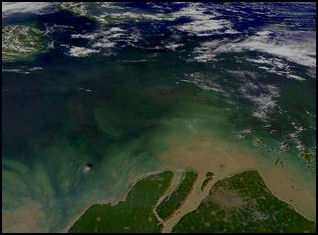
Satellite view of 1998 flood
In 1996, there were large floods on the Huai River in Anhui province. Flood waters turned hilltop villages into islands; left pig and chickens on rooftops; and caused one lake to exceed its shore by five kilometers. A similar flood occurred in 1991. In 1996 there was also severe floods in Hunan and Guangxi. Around the same time as the 1998 Yangtze floods, there were also catastrophic floods on the Nen River around the city of Qiqhar near the Mongolian border. In the summer 1999, monsoon floods caused by the overflowing upper and middle Yangtze, left at least 400 dead and 1.84 million homeless. More than 66 million people were affected.
In June 2007, severe floods struck parts of southern China. Describing a flood that devastated a Dong minority village in Guizhou Province, Amy Tan wrote in National Geographic: “A small amount of flooding was not unusual in summer...But this rain did not stop. People could hear its splattering on their roofs all night long. The Chief Village Elder, who lived in the flat valley, saw the river rising but was not concerned at first. He went to the mountains at 5:00am to feed his horse. When he returned the river had spilled over its ten-foot-high banks. His family was gone, they had already carried the he television and their valuables to the top floor. The neighbors were in the midst of securing coffins and sacred pigs. He watched from the closest bridge.”
”On the other side of the bridge, water rushed into the ground levels homes, “ Tan wrote. “A frightened young woman strapped her baby to her back and she and her in-laws took what they could to the upper level. Other belongings floated away; buckets and stools, pails of anyu and bamboo holsters for scythes. One neighbor’s front door ripped off and became a raft. The narrow road was now part of the river, a dark channel of mud, rocks, debris and logs. Waves slapped on the sides of the shortest bridge, and water gushed through rail slats and covered the benches. It looked like a boat about to leave it mooring. Submerged fields broadened the river, and hundreds of carp rushed downstream. Some landed in fields. People stood on bridge trying to net the rest.
”At 9 a.m. the rain subsided. At 11 a.m. the water began to recede....According to the chief it was the worst flood in 80 to 100 years. Fields were lost. Homes were damaged, roads were washed out, but luckily no one was killed.” The devastation was widespread. All of Guizhou and Hunan Provinces had been affected. Many wondered if the illegal grave curse was still active. Were more illegal burials to be found? A certain sense of releif was achived when the Feng Shui Master announced that the floods were “a natural disaster, not a supernatural one.”
Yangtze Floods in 1998
The worst floods in recent history occurred in 1998 when 4,150 people died, most along the Yangtze. In the summer of that year, the Yangtze experienced its worst floods in 44 years. More than 4,100 people were killed, 13.8 million were left homeless and 240 million people (a number equal to the entire population of the United States) were affected directly by the rising waters.
The floods submerged 21 million acres of land, affected 53 million acres and destroyed 11 million acres of crops. More than 5.8 million houses were destroyed. Dikes were blown up in Jianli County to save Wuhan, a city of seven million people 150 miles upstream. Even so waters reached waist level in downtown Wuhan.
Some people were evacuated on short notice and lost most of their possessions. Some tied their stuff in trees above the flood water because they couldn't carry them. Soldiers and police were called in to evacuate a half million people, keep order, prevent looting and stop the flooding. Dramatic footage was shown on Chinese television of soldiers risking their lives to reach from trees to pluck victims from the raging waters and working hard to shore up dikes with sandbags.
Causes of Yangtze Floods in 1998
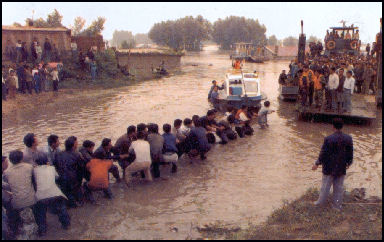
1998 flood survivors
Severe rainfall was the main cause of the floods but man-induced factors included deforestation of erosion-subverting forests in the Yangtze river basin and other areas also contributed to the disaster. Rain water absorbed by forests and vegetation flows more slowly to rivers and streams, preventing flooding. The disaster was linked to a strong El Nino effect that occurred in 1998.
Other problems included the inhabitation of vulnerable flood plains by large numbers of people (550,000 people were evacuated from an area in which 170,000 were evacuated in 1954); the silting up and development of lakes that previously absorbed flood waters; and the neglect of dikes. In 1980, $1.2 billion was earmarked for dike improvement. But by 1987, only $48 million had been spent. Some of the money was diverted to the Three Gorges Dam project.
Corruption and ineptitude were also factors. Large sums of flood prevention money was stolen, much of it by contractors who took money and then gave the work to other contractors who took money without doing any work. In some places, corrupt officials pocketed money intended to be spent on steel rods that was supposed to reinforce the dikes. Without the metal rods some dikes melted away.
After the 1998 floods, dikes were reinforced at considerable expense and hundreds of thousands of people that lived near the banks were forced to relocate.
Image Sources: 1) Landsberger Posters http://www.iisg.nl/~landsberger/; 2) Nolls China website http://www.paulnoll.com/China/index.html ; 3) Columbia University; 4, 7,8 ) NASA ; 5, 6) Xinhua
Text Sources: New York Times, Washington Post, Los Angeles Times, Times of London, National Geographic, The New Yorker, Time, Newsweek, Reuters, AP, Lonely Planet Guides, Compton’s Encyclopedia and various books and other publications.
Last updated June 2022
